Abstract
Bryostatin 1 is a macrocyclic lactone derived from the marine invertebrate Bugula neritina. In vitro, bryostatin 1 activates protein kinase C (PKC), induces the differentiation of a number of cancer cell lineages, exhibits anti-tumour activity and augments the response of haemopoietic cells to certain growth factors. In vivo, bryostatin 1 is also immunomodulatory, but the range of tumours which respond to bryostatin 1 in xenograft tumour models is mostly the same as the in vitro tumour types, suggesting a direct mode of action. Nineteen patients with advanced malignancy were entered into a phase I study in which bryostatin 1 was given as a 24 h intravenous infusion, weekly, for 8 weeks. Myalgia was the dose-limiting toxicity and the maximum tolerated dose was 25 micrograms m-2 per week. The myalgia was cumulative and dose related, and chiefly affected the thighs, calves and muscles of extraocular movement. The mechanism of the myalgia is unknown. CTC grade 1 phlebitis affected every patient for at least one cycle and was caused by the diluent, PET, which contains polyethylene glycol, ethanol and Tween 80. Most patients experienced a 1 g dl-1 decrease in haemoglobin within 1 h of commencing the infusion which was associated with a decrease in haematocrit. Radiolabelled red cell studies were performed in one patient to investigate the anaemia. The survival of radiolabelled red cells during the week following treatment was the same as that seen in the week before treatment. However, there was a temporary accumulation of radiolabelled red cells in the liver during the first hour of treatment, suggesting that pooling of erythrocytes in the liver might account for the decrease in haematocrit. Total or activated PKC concentrations were measured in the peripheral blood mononuclear cells (PBMCs) of three patients for the first 4 h of treatment and during the last hour of the infusion. This showed that PKC activity was significantly modulated during the infusion. Bryostatin 1 is immunomodulatory in vitro, and we have confirmed this activity in vivo. An investigation of the first three cycles of treatment in seven patients showed an increased IL-2-induced proliferative response in peripheral blood lymphocytes and enhanced lymphokine-activated killer (LAK) activity. A previously reported rise in serum levels of interleukin 6 (IL-6) and tumour necrosis factor alpha (TNF 1) was not confirmed in our study; of nine patients in this study, including patients at all dose levels, none showed an increase in these cytokines.(ABSTRACT TRUNCATED AT 400 WORDS)
Full text
PDF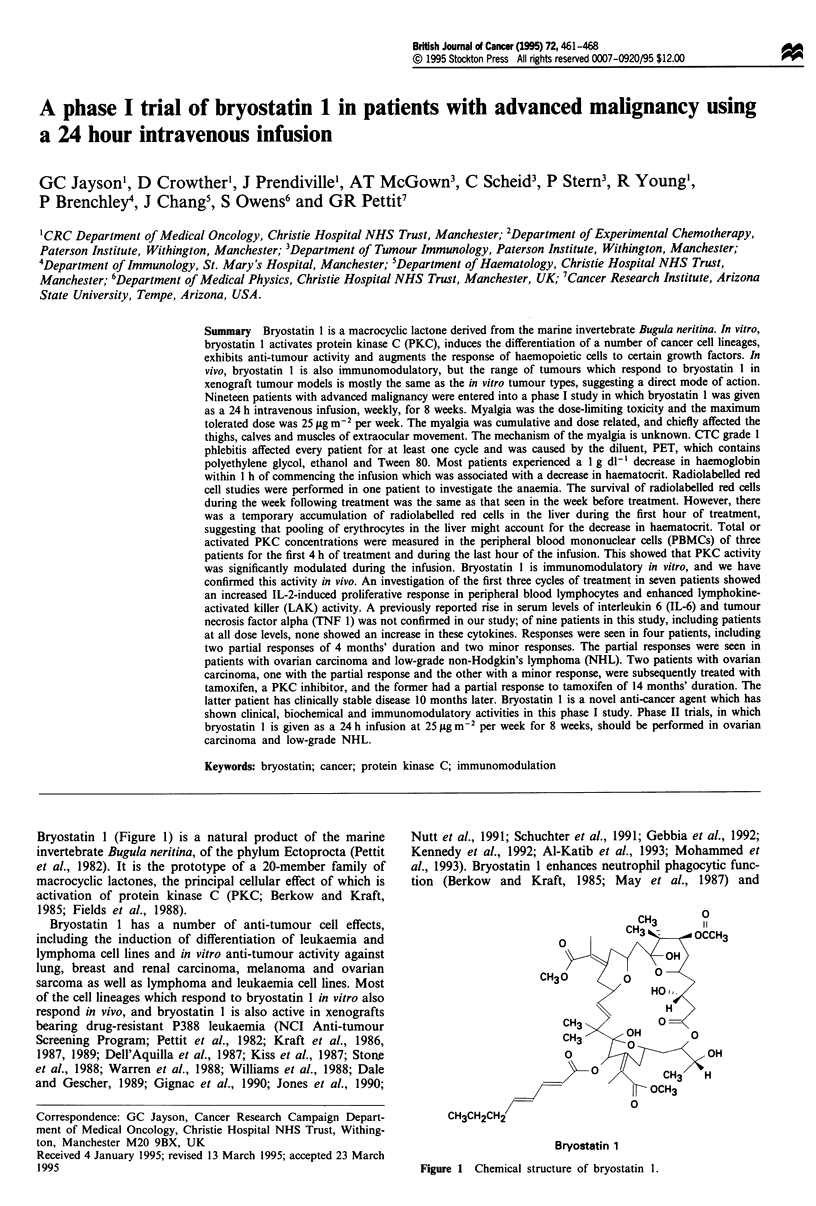
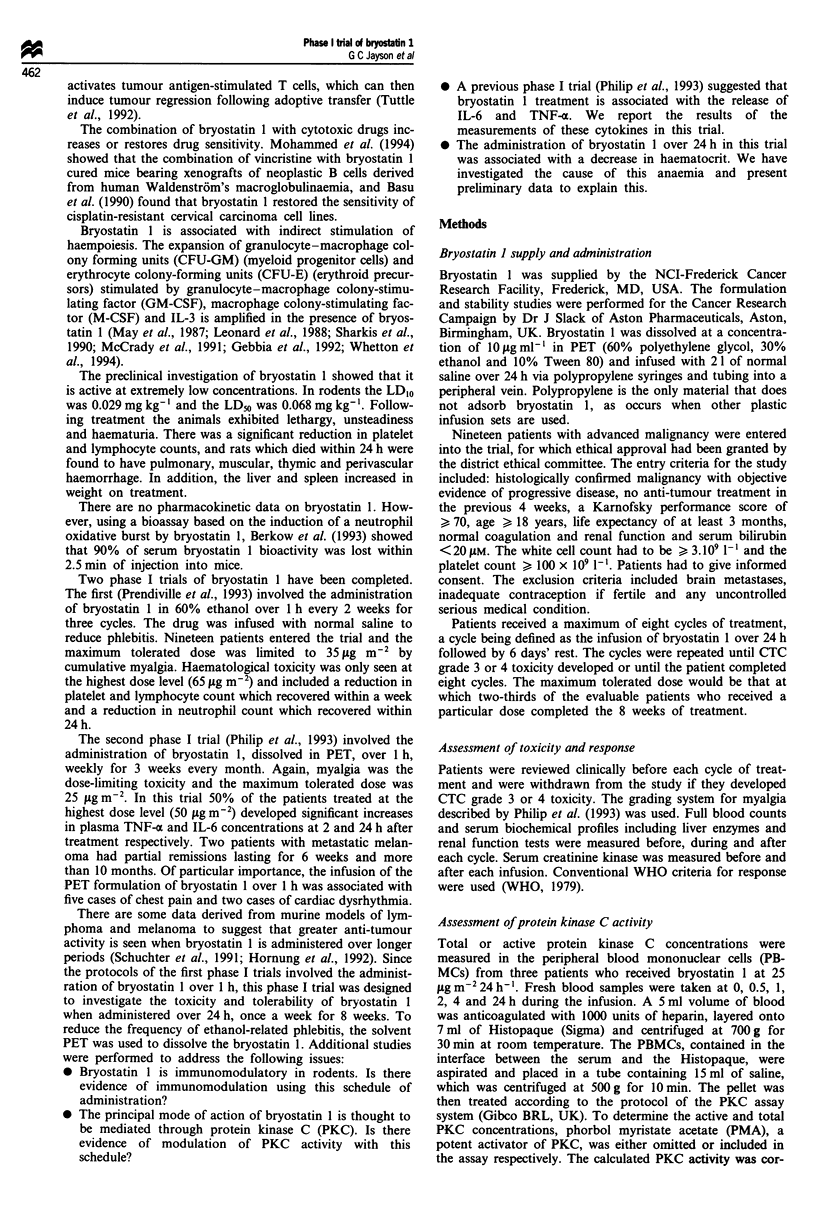
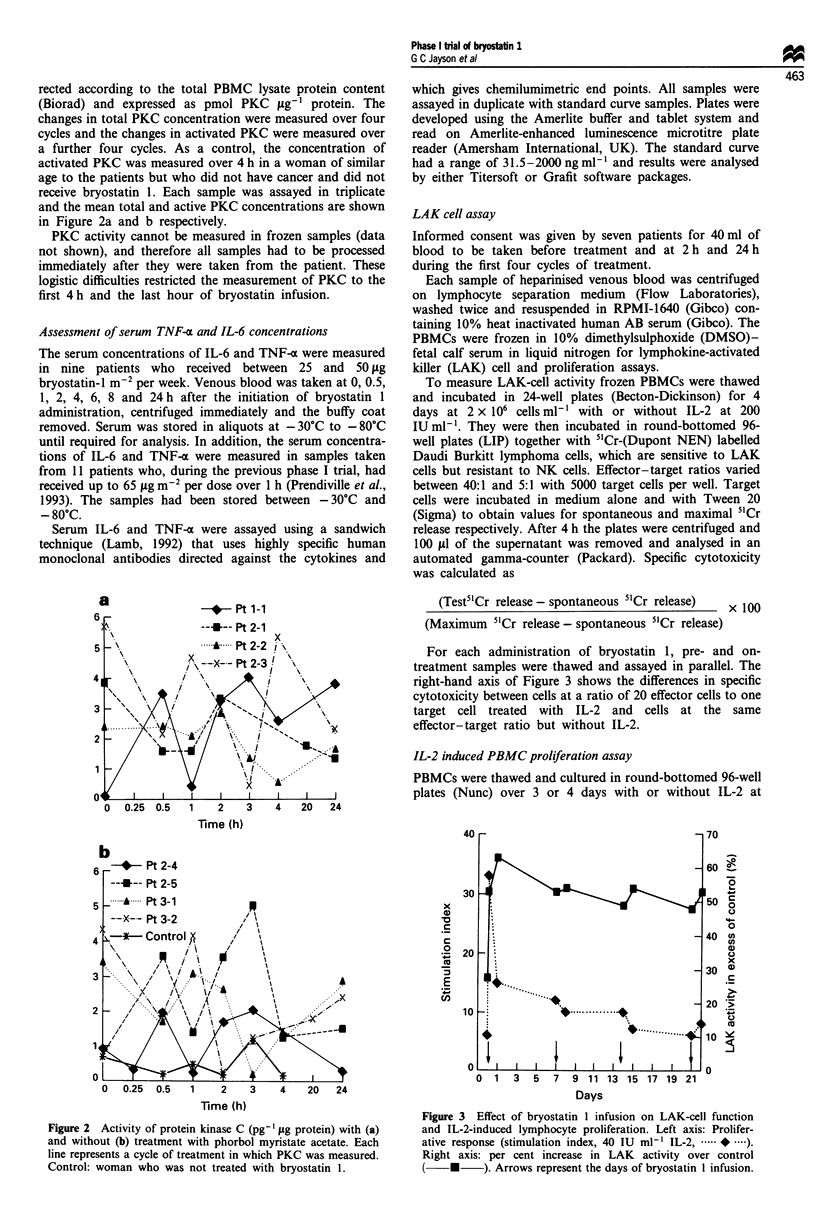
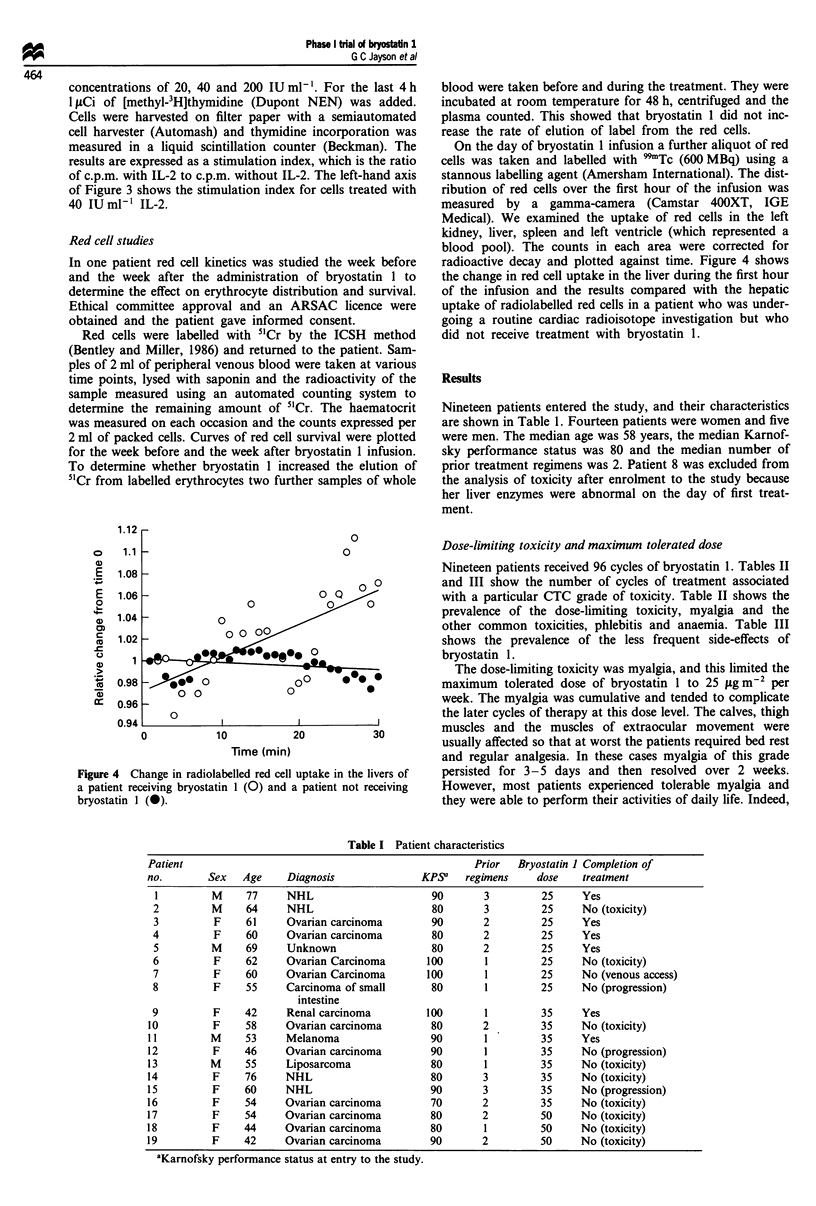
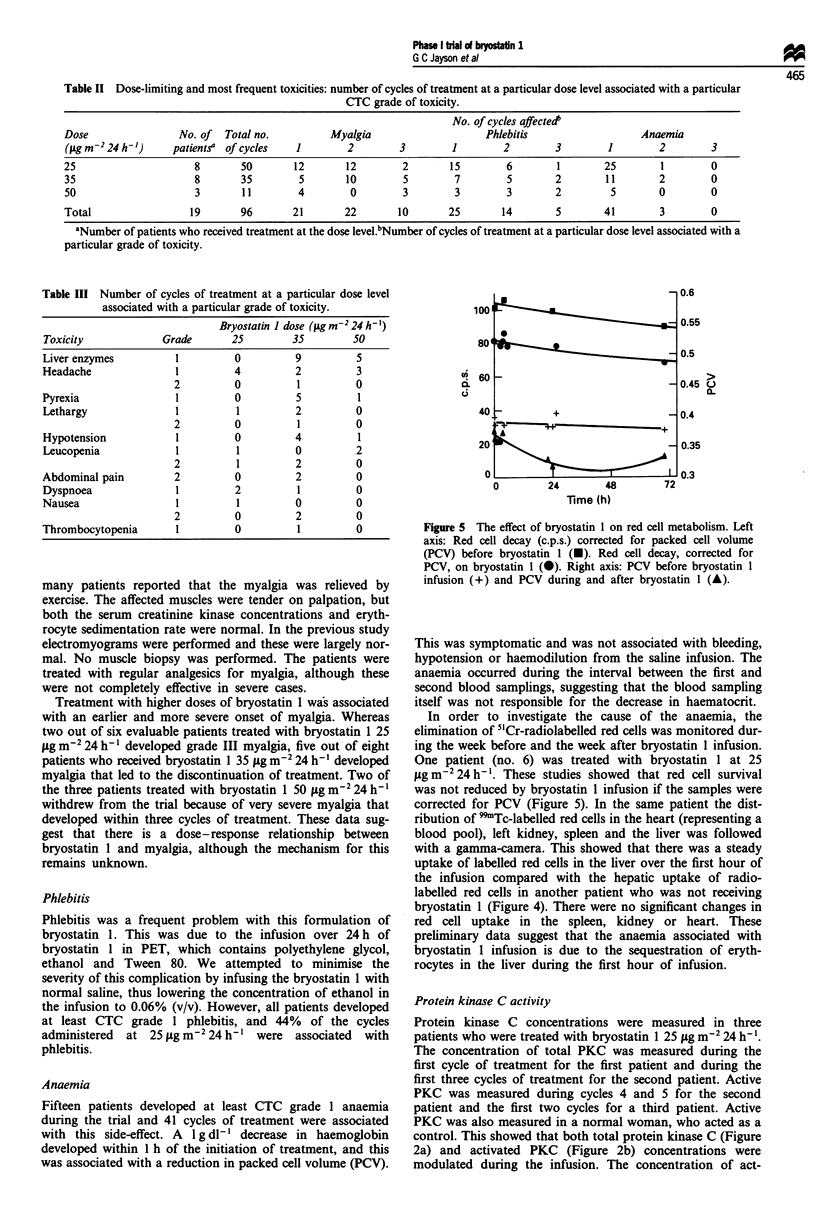
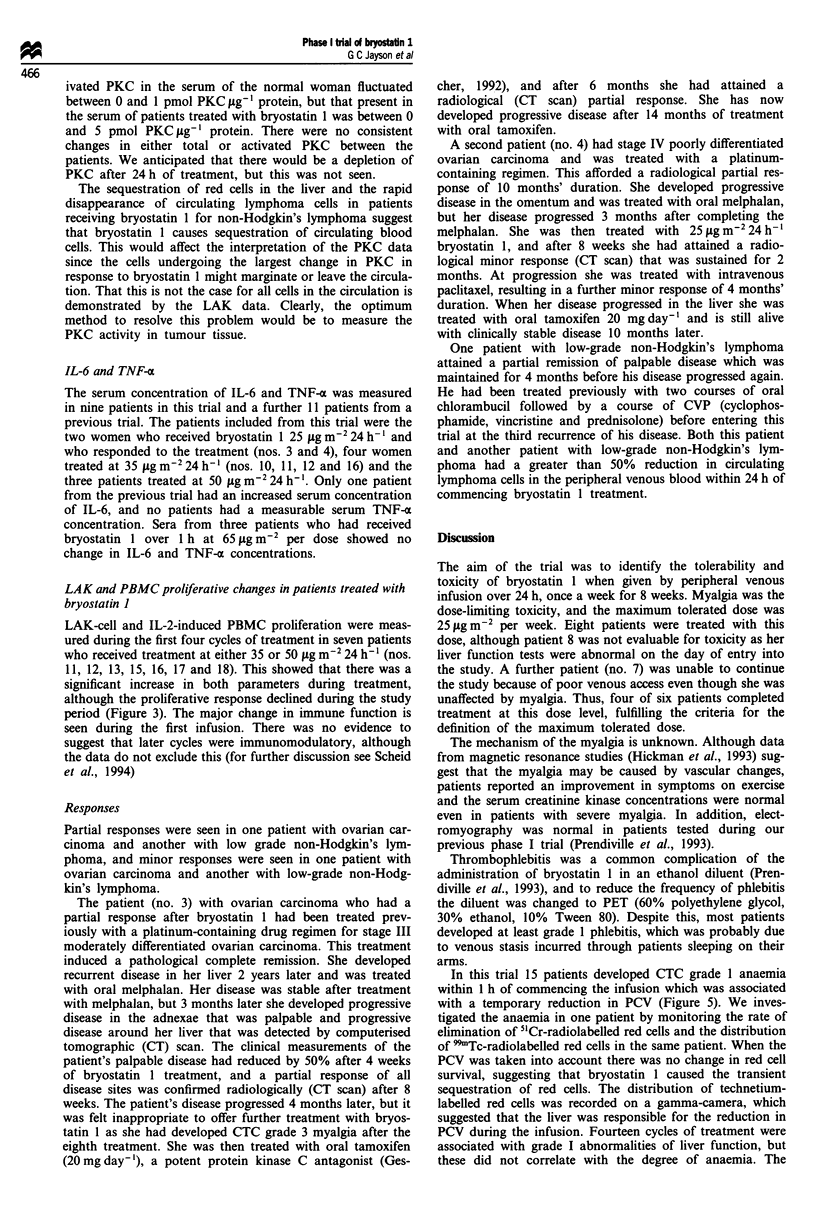
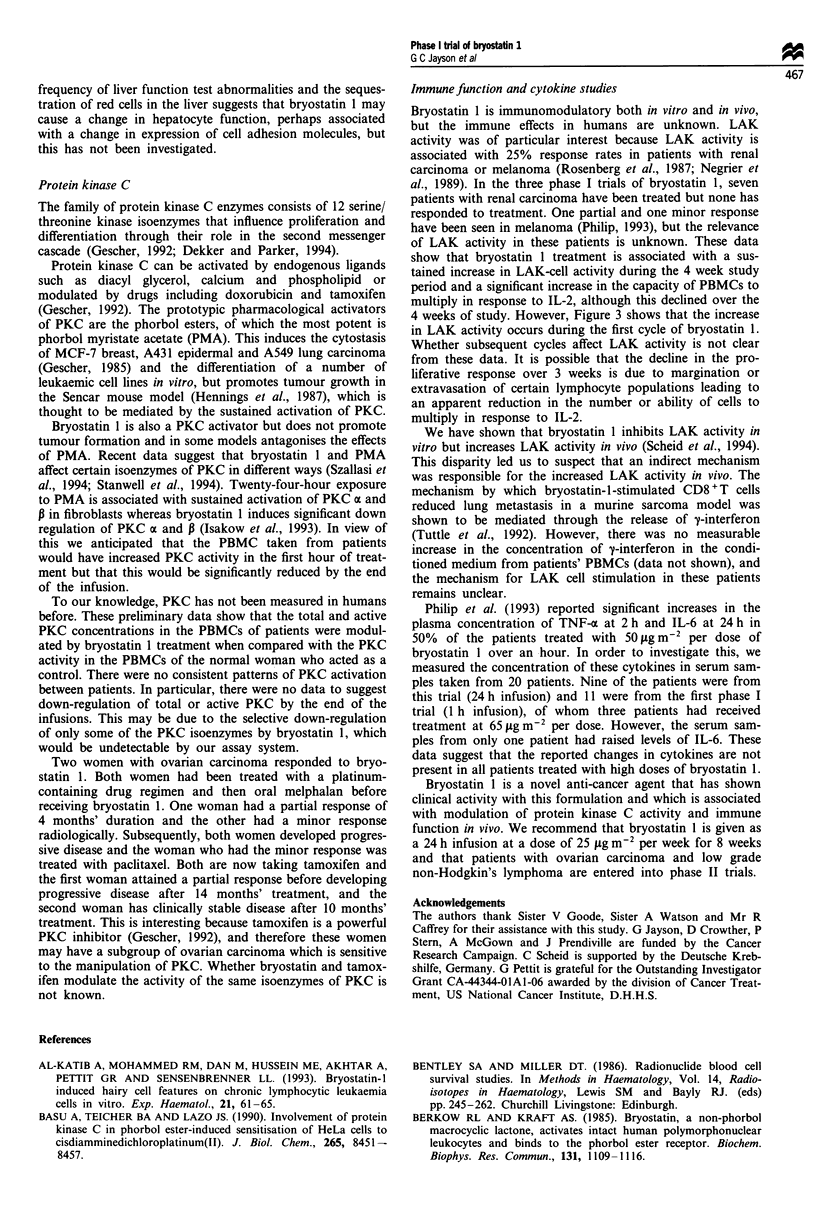
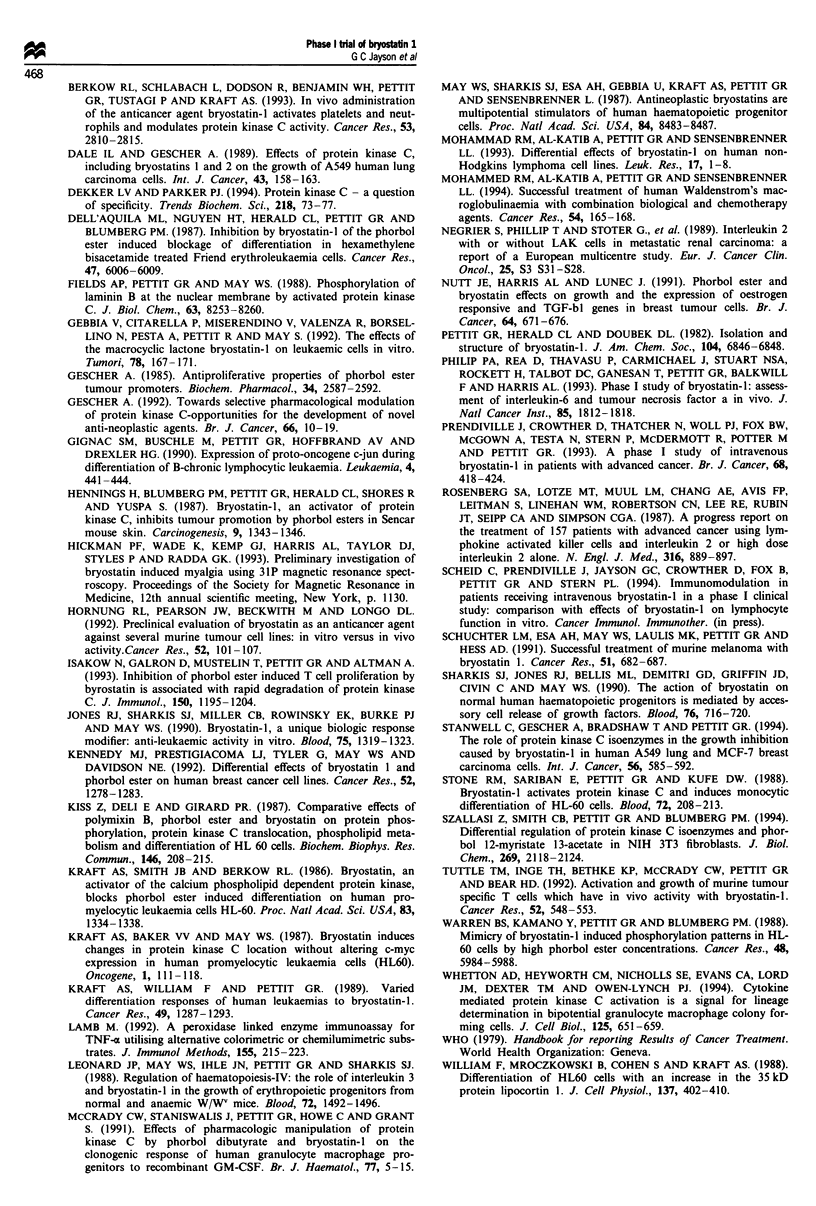
Selected References
These references are in PubMed. This may not be the complete list of references from this article.
- Basu A., Teicher B. A., Lazo J. S. Involvement of protein kinase C in phorbol ester-induced sensitization of HeLa cells to cis-diamminedichloroplatinum(II). J Biol Chem. 1990 May 25;265(15):8451–8457. [PubMed] [Google Scholar]
- Berkow R. L., Kraft A. S. Bryostatin, a non-phorbol macrocyclic lactone, activates intact human polymorphonuclear leukocytes and binds to the phorbol ester receptor. Biochem Biophys Res Commun. 1985 Sep 30;131(3):1109–1116. doi: 10.1016/0006-291x(85)90205-0. [DOI] [PubMed] [Google Scholar]
- Berkow R. L., Schlabach L., Dodson R., Benjamin W. H., Jr, Pettit G. R., Rustagi P., Kraft A. S. In vivo administration of the anticancer agent bryostatin 1 activates platelets and neutrophils and modulates protein kinase C activity. Cancer Res. 1993 Jun 15;53(12):2810–2815. [PubMed] [Google Scholar]
- Dale I. L., Gescher A. Effects of activators of protein kinase C, including bryostatins 1 and 2, on the growth of A549 human lung carcinoma cells. Int J Cancer. 1989 Jan 15;43(1):158–163. doi: 10.1002/ijc.2910430129. [DOI] [PubMed] [Google Scholar]
- Dekker L. V., Parker P. J. Protein kinase C--a question of specificity. Trends Biochem Sci. 1994 Feb;19(2):73–77. doi: 10.1016/0968-0004(94)90038-8. [DOI] [PubMed] [Google Scholar]
- Dell'Aquila M. L., Nguyen H. T., Herald C. L., Pettit G. R., Blumberg P. M. Inhibition by bryostatin 1 of the phorbol ester-induced blockage of differentiation in hexamethylene bisacetamide-treated Friend erythroleukemia cells. Cancer Res. 1987 Nov 15;47(22):6006–6009. [PubMed] [Google Scholar]
- Fields A. P., Pettit G. R., May W. S. Phosphorylation of lamin B at the nuclear membrane by activated protein kinase C. J Biol Chem. 1988 Jun 15;263(17):8253–8260. [PubMed] [Google Scholar]
- Gebbia V., Citarrella P., Miserendino V., Valenza R., Borsellino N., Pesta A., Pettit R., May S. The effects of the macrocyclic lactone bryostatin-1 on leukemic cells in vitro. Tumori. 1992 Jun 30;78(3):167–171. doi: 10.1177/030089169207800304. [DOI] [PubMed] [Google Scholar]
- Gescher A. Antiproliferative properties of phorbol ester tumour promoters. Biochem Pharmacol. 1985 Aug 1;34(15):2587–2592. doi: 10.1016/0006-2952(85)90552-0. [DOI] [PubMed] [Google Scholar]
- Gescher A. Towards selective pharmacological modulation of protein kinase C--opportunities for the development of novel antineoplastic agents. Br J Cancer. 1992 Jul;66(1):10–19. doi: 10.1038/bjc.1992.209. [DOI] [PMC free article] [PubMed] [Google Scholar]
- Gignac S. M., Buschie M., Pettit G. R., Hoffbrand A. V., Drexler H. G. Expression of proto-oncogene c-jun during differentiation of B-chronic lymphocytic leukemia. Leukemia. 1990 Jun;4(6):441–444. [PubMed] [Google Scholar]
- Hennings H., Blumberg P. M., Pettit G. R., Herald C. L., Shores R., Yuspa S. H. Bryostatin 1, an activator of protein kinase C, inhibits tumor promotion by phorbol esters in SENCAR mouse skin. Carcinogenesis. 1987 Sep;8(9):1343–1346. doi: 10.1093/carcin/8.9.1343. [DOI] [PubMed] [Google Scholar]
- Hornung R. L., Pearson J. W., Beckwith M., Longo D. L. Preclinical evaluation of bryostatin as an anticancer agent against several murine tumor cell lines: in vitro versus in vivo activity. Cancer Res. 1992 Jan 1;52(1):101–107. [PubMed] [Google Scholar]
- Isakov N., Galron D., Mustelin T., Pettit G. R., Altman A. Inhibition of phorbol ester-induced T cell proliferation by bryostatin is associated with rapid degradation of protein kinase C. J Immunol. 1993 Feb 15;150(4):1195–1204. [PubMed] [Google Scholar]
- Jones R. J., Sharkis S. J., Miller C. B., Rowinsky E. K., Burke P. J., May W. S. Bryostatin 1, a unique biologic response modifier: anti-leukemic activity in vitro. Blood. 1990 Mar 15;75(6):1319–1323. [PubMed] [Google Scholar]
- Kennedy M. J., Prestigiacomo L. J., Tyler G., May W. S., Davidson N. E. Differential effects of bryostatin 1 and phorbol ester on human breast cancer cell lines. Cancer Res. 1992 Mar 1;52(5):1278–1283. [PubMed] [Google Scholar]
- Kiss Z., Deli E., Girard P. R., Pettit G. R., Kuo J. F. Comparative effects of polymyxin B, phorbol ester and bryostatin on protein phosphorylation, protein kinase C translocation, phospholipid metabolism and differentiation of HL60 cells. Biochem Biophys Res Commun. 1987 Jul 15;146(1):208–215. doi: 10.1016/0006-291x(87)90712-1. [DOI] [PubMed] [Google Scholar]
- Kraft A. S., Baker V. V., May W. S. Bryostatin induces changes in protein kinase C location and activity without altering c-myc gene expression in human promyelocytic leukemia cells (HL-60). Oncogene. 1987 May;1(2):111–118. [PubMed] [Google Scholar]
- Kraft A. S., Smith J. B., Berkow R. L. Bryostatin, an activator of the calcium phospholipid-dependent protein kinase, blocks phorbol ester-induced differentiation of human promyelocytic leukemia cells HL-60. Proc Natl Acad Sci U S A. 1986 Mar;83(5):1334–1338. doi: 10.1073/pnas.83.5.1334. [DOI] [PMC free article] [PubMed] [Google Scholar]
- Kraft A. S., William F., Pettit G. R., Lilly M. B. Varied differentiation responses of human leukemias to bryostatin 1. Cancer Res. 1989 Mar 1;49(5):1287–1293. [PubMed] [Google Scholar]
- Lamb W. R., Pumphrey R. S., Brenchley P. E. A peroxidase-linked enzyme immunoassay for tumour necrosis factor alpha utilising alternative colorimetric or chemilumimetric substrates. J Immunol Methods. 1992 Nov 5;155(2):215–223. doi: 10.1016/0022-1759(92)90288-5. [DOI] [PubMed] [Google Scholar]
- Leonard J. P., May W. S., Ihle J. N., Pettit G. R., Sharkis S. J. Regulation of hematopoiesis-IV: The role of interleukin-3 and bryostatin 1 in the growth of erythropoietic progenitors from normal and anemic W/Wv mice. Blood. 1988 Nov;72(5):1492–1496. [PubMed] [Google Scholar]
- May W. S., Sharkis S. J., Esa A. H., Gebbia V., Kraft A. S., Pettit G. R., Sensenbrenner L. L. Antineoplastic bryostatins are multipotential stimulators of human hematopoietic progenitor cells. Proc Natl Acad Sci U S A. 1987 Dec;84(23):8483–8487. doi: 10.1073/pnas.84.23.8483. [DOI] [PMC free article] [PubMed] [Google Scholar]
- McCrady C. W., Staniswalis J., Pettit G. R., Howe C., Grant S. Effect of pharmacologic manipulation of protein kinase C by phorbol dibutyrate and bryostatin 1 on the clonogenic response of human granulocyte-macrophage progenitors to recombinant GM-CSF. Br J Haematol. 1991 Jan;77(1):5–15. doi: 10.1111/j.1365-2141.1991.tb07941.x. [DOI] [PubMed] [Google Scholar]
- Mohammad R. M., al-Katib A., Pettit G. R., Sensenbrenner L. L. Successful treatment of human Waldenström's macroglobulinemia with combination biological and chemotherapy agents. Cancer Res. 1994 Jan 1;54(1):165–168. [PubMed] [Google Scholar]
- Nutt J. E., Harris A. L., Lunec J. Phorbol ester and bryostatin effects on growth and the expression of oestrogen responsive and TGF-beta 1 genes in breast tumour cells. Br J Cancer. 1991 Oct;64(4):671–676. doi: 10.1038/bjc.1991.379. [DOI] [PMC free article] [PubMed] [Google Scholar]
- Philip P. A., Rea D., Thavasu P., Carmichael J., Stuart N. S., Rockett H., Talbot D. C., Ganesan T., Pettit G. R., Balkwill F. Phase I study of bryostatin 1: assessment of interleukin 6 and tumor necrosis factor alpha induction in vivo. The Cancer Research Campaign Phase I Committee. J Natl Cancer Inst. 1993 Nov 17;85(22):1812–1818. doi: 10.1093/jnci/85.22.1812. [DOI] [PubMed] [Google Scholar]
- Prendiville J., Crowther D., Thatcher N., Woll P. J., Fox B. W., McGown A., Testa N., Stern P., McDermott R., Potter M. A phase I study of intravenous bryostatin 1 in patients with advanced cancer. Br J Cancer. 1993 Aug;68(2):418–424. doi: 10.1038/bjc.1993.352. [DOI] [PMC free article] [PubMed] [Google Scholar]
- Rosenberg S. A., Lotze M. T., Muul L. M., Chang A. E., Avis F. P., Leitman S., Linehan W. M., Robertson C. N., Lee R. E., Rubin J. T. A progress report on the treatment of 157 patients with advanced cancer using lymphokine-activated killer cells and interleukin-2 or high-dose interleukin-2 alone. N Engl J Med. 1987 Apr 9;316(15):889–897. doi: 10.1056/NEJM198704093161501. [DOI] [PubMed] [Google Scholar]
- Schuchter L. M., Esa A. H., May S., Laulis M. K., Pettit G. R., Hess A. D. Successful treatment of murine melanoma with bryostatin 1. Cancer Res. 1991 Jan 15;51(2):682–687. [PubMed] [Google Scholar]
- Sharkis S. J., Jones R. J., Bellis M. L., Demetri G. D., Griffin J. D., Civin C., May W. S. The action of bryostatin on normal human hematopoietic progenitors is mediated by accessory cell release of growth factors. Blood. 1990 Aug 15;76(4):716–720. [PubMed] [Google Scholar]
- Stanwell C., Gescher A., Bradshaw T. D., Pettit G. R. The role of protein kinase C isoenzymes in the growth inhibition caused by bryostatin 1 in human A549 lung and MCF-7 breast carcinoma cells. Int J Cancer. 1994 Feb 15;56(4):585–592. doi: 10.1002/ijc.2910560420. [DOI] [PubMed] [Google Scholar]
- Stone R. M., Sariban E., Pettit G. R., Kufe D. W. Bryostatin 1 activates protein kinase C and induces monocytic differentiation of HL-60 cells. Blood. 1988 Jul;72(1):208–213. [PubMed] [Google Scholar]
- Szallasi Z., Smith C. B., Pettit G. R., Blumberg P. M. Differential regulation of protein kinase C isozymes by bryostatin 1 and phorbol 12-myristate 13-acetate in NIH 3T3 fibroblasts. J Biol Chem. 1994 Jan 21;269(3):2118–2124. [PubMed] [Google Scholar]
- Tuttle T. M., Inge T. H., Bethke K. P., McCrady C. W., Pettit G. R., Bear H. D. Activation and growth of murine tumor-specific T-cells which have in vivo activity with bryostatin 1. Cancer Res. 1992 Feb 1;52(3):548–553. [PubMed] [Google Scholar]
- Warren B. S., Kamano Y., Pettit G. R., Blumberg P. M. Mimicry of bryostatin 1 induced phosphorylation patterns in HL-60 cells by high-phorbol ester concentrations. Cancer Res. 1988 Nov 1;48(21):5984–5988. [PubMed] [Google Scholar]
- Whetton A. D., Heyworth C. M., Nicholls S. E., Evans C. A., Lord J. M., Dexter T. M., Owen-Lynch P. J. Cytokine-mediated protein kinase C activation is a signal for lineage determination in bipotential granulocyte macrophage colony-forming cells. J Cell Biol. 1994 May;125(3):651–659. doi: 10.1083/jcb.125.3.651. [DOI] [PMC free article] [PubMed] [Google Scholar]
- William F., Mroczkowski B., Cohen S., Kraft A. S. Differentiation of HL-60 cells is associated with an increase in the 35-kDa protein lipocortin I. J Cell Physiol. 1988 Dec;137(3):402–410. doi: 10.1002/jcp.1041370303. [DOI] [PubMed] [Google Scholar]
- al-Katib A., Mohammad R. M., Dan M., Hussein M. E., Akhtar A., Pettit G. R., Sensenbrenner L. L. Bryostatin 1-induced hairy cell features on chronic lymphocytic leukemia cells in vitro. Exp Hematol. 1993 Jan;21(1):61–65. [PubMed] [Google Scholar]


